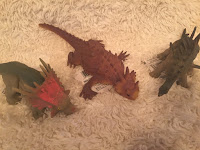Our bodies
are designed to import sensory information from receptors throughout our
bodies, send it to our brains and process that information in order to form a
response to that input. We have tactile
and temperature receptors in our skin, auditory receptors in our ears,
receptors in our joints that tell us where we are in space, visual receptors in
our eyes, taste buds in our mouths, etc. The input we receive helps us adjust
our actions, learn about our environment and respond to situations. Problems
arise when a person doesn’t process sensory information in the typical way. This
article gives a brief introduction to Tactile Defensiveness or TD—what it is
and some elementary suggestions that might help families who are struggling.
Some people
respond negatively to what the majority of people find pleasurable or
neutral. Tactile Defensiveness is the
term that describes a negative reaction to sensory information received by our
skin. (Sensory Integration is a broader
term that describes how a person processes all of the sensory information our
body receives). Some children over-react
to touch and some children under-react to touch. Children have a wide range of responses to
TD, manifesting emotional and/or behavioral changes from mild fidgeting or
restlessness to major meltdowns that seemingly come from ‘out of nowhere’. To
the child, the sensation can seem noxious or even painful; they are not trying
to be defiant. Further, when children withdraw and do not engage in touch and
tactile play, their learning experiences are limited, which can lead to delays
in gross motor and fine motor skill acquisition.
There are
multiple issues that arise when a child has Tactile Defensiveness. Children with TD frequently dislike being
hugged, kissed, or cuddled, leading parents to feel rejected and
inadequate. Thoughts and feelings surface,
like: “I must be a terrible parent. My
child does even like my touch!” Clothing can frequently cause problems for
people with Tactile Defensiveness and lead to dressing battles between parents
and kids—there is commonly an intolerance to particular textures or an extreme
reaction to label tags in clothing or wearing socks. Taking a child on a family vacation to a
sandy beach can cause a major meltdown for a child with tactile problems. The
texture or consistency of certain foods can be a problem as well. A child may
be intolerant of a food that is slippery (think ripe banana or canned peaches),
grainy (think peas or lima beans), foods that are cold or hot, or foods that
are touching each other. Sometimes just
switching from one food to another during a meal can be difficult due to the
difference in texture or temperature. Bath time can be a battle—splashing water,
temperature of the water, nakedness, toweling off.
How can we
help children who have sensory processing difficulties? First and foremost, I
would recommend a thorough evaluation by an Occupational or Physical Therapist
who specializes in Sensory Processing Disorders (SPD). They will be able to identify issues and
design a treatment plan for your child and family.
Some Activities to Try:
- Deep pressure (weighted vests, weighted blankets, weighted lap animals) can often help calm a child who is fidgety or irritated. It helps to “desensitize” a child.
- Pushing a wheelbarrow outside, a weighted walking toy, a Tonka truck laden with stones or sand can also be valuable as a way of “grounding” a child and giving their body a better sense of where they are in space.
 |
| Add Weights to a Walking Push Toy for Increased Workload and Tactile Input |
- Toys That Provide Proprioceptive Input: A ride on toy (using feet like a “Flintstone Car”) for a young child or using a scooter, scooter board or bicycle for an older child are other activities that may be better received by a child with sensory issues and give their bodies input that can be tolerated.
- Spinning on a sit-n-spin or swinging on a swing can provide vestibular stimulation that can be calming and help a child “organize”.
 |
| Sit and Spin Toy for Providing Vestibular Stimulation |
- Tactile Experiences: Rice or Bean containers can help those children who enjoy more of a mess or need increased input to their hands. Purchase an 8-10-quart container with a lid and bury favorite toys under the rice and let them dig them out.
- Tactile Toys can also help calm and settle some children. Some types to try: Squishy Toys, spikey balls, Play Doh, “Slime”, Koosh balls, Silly Putty, or Fabric Books (pages made from cloth of differing textures) can also help calm and settle certain children.
ADDITIONAL SUGGESTIONS:
- For kids who under-react to touch, they need to be taught safety around things like stoves (all hot surfaces), scratching too hard, or cold weather. An injury or fall that other kids would automatically report to their parents might not even phase a child with sensory processing issues.
- Remove tags from clothing or buy shirts without labels. Purchase seamless socks.
- Guide older children in doing things for themselves like brushing teeth, washing their face, combing their hair. You can instruct them by using a life-like doll. This can serve to reduce major battles over self-help skills and decrease the number of direct contacts/touches.
- Buy plates that have divided sections to keep food from touching. Allow your child to eat all of one food first before insisting they start another.
Remember that your child is reacting to stimulation they perceive as noxious. Work with your child’s therapists to find the best treatment plan and alternative ways of interacting that will help your child grow and lead a rewarding life. Accept them for the wonderful person they are. Advocate for them.
Love them!
Author: Trisha Roberts










lovely
ReplyDelete